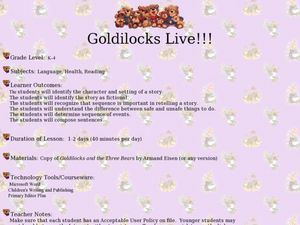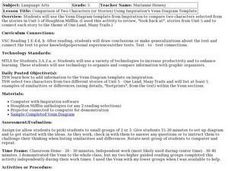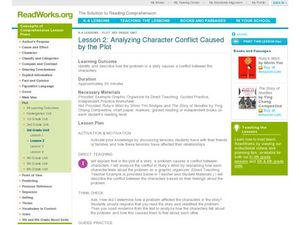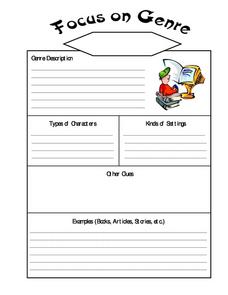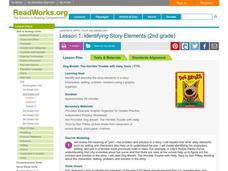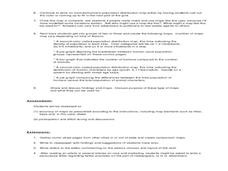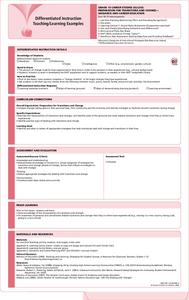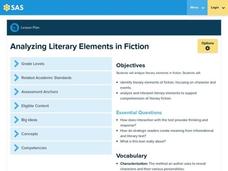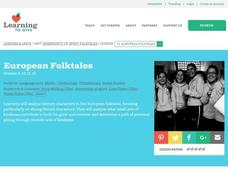Curated OER
Design a Book Cover
Students use the programs Pics4Learning and ImageBlender 3 to apply their knowledge of characters, plot, setting, symbolism, and conflict to design and create a book cover. Designed as a culminating literature activity.
Curated OER
Nursery Rhymes
Students recall details of nursery rhyme read by teacher, identify main characters, and demonstrate knowledge of poem by creating concept map about story that includes title, clip art, and changes in font and color.
Curated OER
Chocolate Chaos
Second graders demonstrate the ability to examine the elements of a story (theme, plot, setting, mood) and characters, by discussing and writing about each. They have fun with chocolate related activities and enjoy reading about some...
Curated OER
Popsicle Stick Kids
Students use popsicle sticks to make different characters. They use fabric to make the clothes and even place eyes to make them seem more real. They add jewelry and any other fashion item to complete the character.
Curated OER
Thinking About Money
Young scholars explore the concept of a personal budget. In this philanthropy lesson, students use a Venn diagram to compare 2 stories in which the main characters spend money in different ways.
Curated OER
And the Moral of the Story is...
Students retell a story using computer software. In this story elements lesson, students retell the story giving the plot, setting, characters and moral using Pixie software.
Curated OER
The Clock Tower on Grand Avenue: A Cultural Reading Adventure
Sixth graders read three novels to practice their reading and comprehension skills. Using each novel, they create a list of the characteristics of each culture represented. In groups, they also identify the setting, characters and plot...
Curated OER
Children's Books Teach Diversity, Respect
Young scholars compare aspects of children's books that teach diversity and respect. They examine universal values such as courage and bravery, respect and apathy. They create a final project based on their ability to recognize the...
Curated OER
Novel Jeopardy
Play a classroom version of the classic game show Jeopardy, to review and discuss the novel your class has been reading. Questions about plot and other story elements are written on cards and given point values. Divide the class into...
Curated OER
The World Around Me
Combining visual and language arts, here is a resource that prompts middle schoolers to write stories based on pictures of their surroundings. They use digital cameras to take pictures of favorite areas in the school. Next, they choose...
Curated OER
When A Story Met A Sandwich
How is a story like a peanut butter and jelly sandwich? Use making a sandwich as a metaphor to remind your writers that a good, solid beginning, a rich and rewarding middle, and an ending that brings everything together spices up a...
Curated OER
Goldilocks Live!!!
Study story elements with your young learners. Read Goldilocks and the Three Bears and discuss the order of events by making a story panel out of butcher paper. Sentences are given as suggestions for the panel, though you may...
Curated OER
Presenting Your Case
Pupils write letter from historical figure's point of view using proper letter writing conventions, write about two props/artifacts that are representative of their subject's life, and use Internet resources to gather images to use in...
Curated OER
Character Map
A character map worksheeth as this would be handy for your class to support characterization study for any text. It is completely adaptable: your learners choose a character, write three traits in ovals and identify two instances that...
Curated OER
Comparison of Two Characters Using Venn Diagram
Fifth graders compare characters of stories using venn diagrams. The use of technology is integrated into the lesson to meet a standard and engage learners.
Curated OER
Analyzing Character Conflict Caused by the Plot
How do we know how a character was affected by the conflicts they encounter in a story? We use evidence from the text to make assertions about the characters we read about. Third graders practice finding and using evidence in a...
Curated OER
Focus on Genre
In this focus on genre worksheet, students describe the genre they are reading, types of characters, kinds of settings, and examples of other forms of the same genre. Students answer five short answer questions.
Curated OER
Identifying Story Elements
Second graders explore story elements. In this language arts lesson plan, 2nd graders identifying characters, setting, and plot in familiar stories. Students listen to a story and complete a graphic organizer.
Curated OER
What is the Population Distribution of Cartoon Characters Living On the Pages of Your Newspaper?
Students read various cartoons in their local newspaper and calculate the population demographics, spatial distribution and grouping of the characters. Using this information, they create a population distribution map and share them with...
EduGAINs
Preparation for Transitions and Change— Guidance and Career Education
Every hopeful in your class has gone through some kind of life change, from parents' divorce to a death in the family to moving up into another grade. Encourage them to discuss these changes, the skills they used and acquired...
Pennsylvania Department of Education
Analyzing Literary Elements in Fiction
Students analyze the characters and events in fictional writing. In this literary elements lesson, students study the meaning of the words characterization and fiction. They listen to the story Pigsty by Mark Teague, or any other book...
Curated OER
European Folktales
Students analyze strong female characters infive different European folktales. In this European folktales instructional activity, students identify the setting and culture described in each folktale to gain understanding of the...
Curated OER
Story Map
In this story map worksheet, students write about a story's setting, characters, problem, and solution. The worksheet is organized as a graphic organizer.
Curated OER
The Bones of a Story
For this Language Arts worksheet, students read a Clifford book and describe 5 story elements. These include title, setting, characters, problem, events, and resolution.
Other popular searches
- Characters and Setting
- Main Characters and Setting
- Plot, Characters and Setting
- Main Character and Setting
- Story Characters and Setting
- Plot Characters and Setting
- Characters & Setting
- Plot Setting Characters
- Characters \& Setting
- Characters Setting











